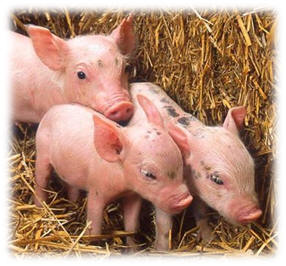Reproduction:
From five months on, a female pig comes into heat approximately
every 21 days. A normal heat lasts approximately 1-3 days. Gilts,
females not yet fit to bear young, usually have one or more heats
before birthing eligibility. After about eight months of age, or the
third heat, gilts should be prepared for mating.
Heat detection becomes very important when breeding. Heat signs are
more easily detected in gilts rather than in mature females (sows). Some signs
include:
· Flushed or swollen vulva – gilts may show this 2-3 days prior to heat
·
Nervousness and more than usual grunting
·
Vaginal discharge – sometimes becomes tacky in texture
·
Mounting among groups of sows
There will be no noticeable bleeding after the heat period, which is
common in other barn yard animals. The most common way to catch a
sow in heat is to allow them to run around a pen with a boar.
Although this is probably the easiest method of mating, it is nearly
impossible to know which boar impregnated the sow – that is of
course, unless
there is only one boar.
Domestically hand mating is common – “Direct producer supervision of
matings without the boar being allowed to run with the sow herd. The
desired sow and boar are placed together and, after mating, returned
to their separate constituent pens. (Kolber)”
How do you know your gilt is impregnated?
Following mating there will be a “seminal plug” appearing in the
possibly impregnated gilt. This “seminal plug” is formed from the
ejaculate material and prevents semen from leaking out of the
reproductive tract. There might also be a quite strong floury smell.
Also the appearance of the fur on the sow’s back can be a sign of
mounting.
Gestation
A sow is pregnant for an average of 114 days - 3 months, 3 weeks, and 3 days. During this time of pregnancy a gilt needs to gain a significant amount of weight. Commonly it is preferred to gain approximately 125 pounds. This weight gain will ensure a healthy liter and maintain healthy nutrition. This requirement is increased when cold or raw weather is present. The females may need extra rations of food in conditions such as these.
I n
the third gestation period of gestation, the litter makes the
largest rush of growth. This demands the sow’s body reserves to
increase dramatically. During this important period the rations of
food may need to be increased by as much as 1-2 pounds. This would be
the time to provide the highest quality nutrition, if it is
available.
n
the third gestation period of gestation, the litter makes the
largest rush of growth. This demands the sow’s body reserves to
increase dramatically. During this important period the rations of
food may need to be increased by as much as 1-2 pounds. This would be
the time to provide the highest quality nutrition, if it is
available.
Farrowing
Farrowing is the act of giving birth. A progression of signs can tell the day of farrowing. There may be a noticeable filling out of the sow in her last month of pregnancy (see gestation). Sometime within the day of the birthing event the sow may make attempt at building a nest. Even if she is confined to a crate or small fencing area she may try to scrape bedding back with her feet to make a mounded nest.
As the moment nears, which is commonly at night,
the pregnant sow may become increasingly and visibly nervous.
Other sows and especially boars should be kept away at this time to
decrease distraction. Most breeders prefer to be present
during farrowing time, even if that means staying up all night.

When forrowing is moments away, the sow will increase the number of grunts and let out an occasional squeal. She will get up and then lay down repetitively for minutes as gestation is approaching. This means piglets should be arriving within the hour of the first couple labor strains. All piglets should be born within three hours of the arrival of number one.



